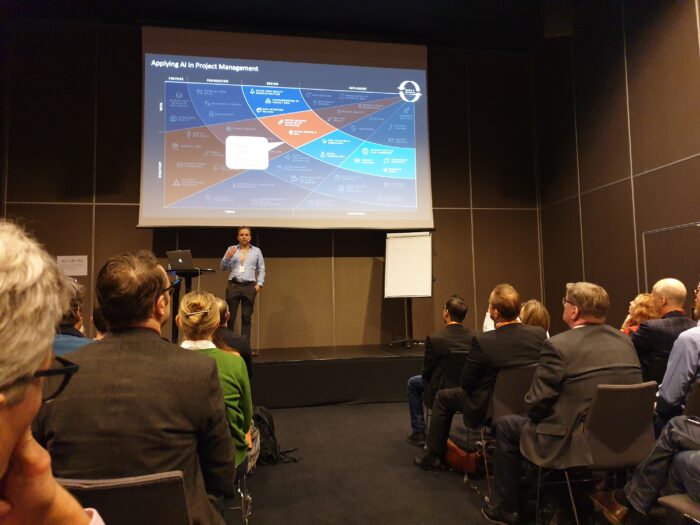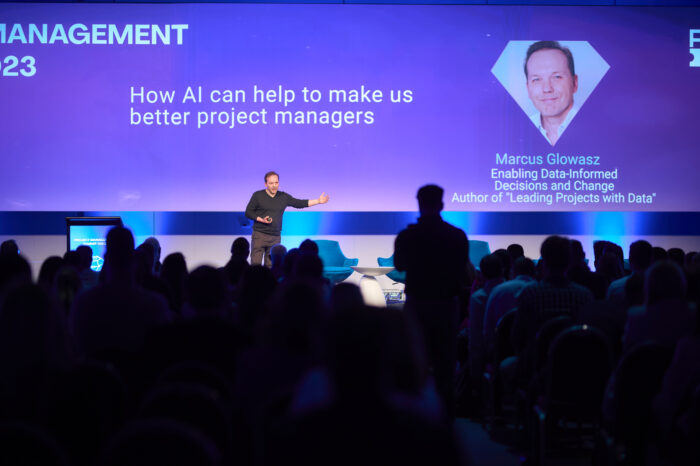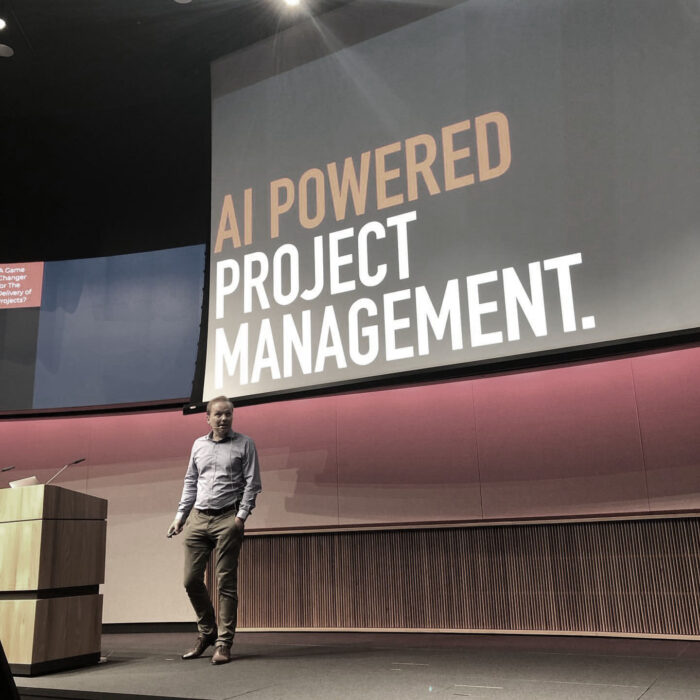Interview with Marcus Glowasz conducted by Aneta Wereszczak
Could you share your journey and experiences that led you to become a specialist in leveraging data and analytics capabilities within project management?
I began my project management career approximately 15 years ago with a strong ambition to make a significant impact in the organization I was working for. I believed that, in general, we could do much better in projects. Naturally, I learned the hard way that projects have numerous unknowns and uncertainties that require adept management, rather than adhering to an exact science. Nevertheless, I was determined to learn and explore how to minimize uncertainty in project decisions to enhance our professional competence in projects.
A moment that deeply influenced me occurred when I was working for a large global bank. I was fortunate to be entrusted with overseeing a critical program in the compliance domain, specifically the area of Anti-Money Laundering / Anti-Financial Crime. I soon recognized synergies between the operational aspects of this domain and the practice of project management. Both areas are primarily about having the right combination of information, expertise, and experience to make sound judgments. Within Anti-Money Laundering, compliance personnel face critical decisions – such as assessing the trustworthiness of potential bank customers for client onboarding. These decisions are highly data-driven, ensuring prompt, precise, and fact-based determinations that mitigate uncertainty. Consequently, data and information are treated as invaluable assets within these domains, with data quality usually being one of the main priorities.
This experience, particularly the management and organization of data and knowledge, led me to explore similar methods for project management. In project management, we often have critical decisions to be made, with the potential of influencing project outcomes substantially – be it concerning project risks, resource allocation, or project planning, just to name a few areas. And what initially started as a small research project when I was doing an MBA, evolved into a passion that has driven me for nearly six years now, and continues to do so.
 Fot. Marcus Glowasz Archive
Fot. Marcus Glowasz ArchiveOvercoming cultural and behavioral barriers is a significant aspect of your work. Can you share some practical strategies you’ve employed to drive cultural change and enable data-informed practices within project teams and organizations?
Despite all the hype about data, analytics, and primarily AI, it must be clear that people remain the key factor in projects. AI has zero value without data, and data has zero value if people are not bought into data as a concept. In the end, data is produced through people’s activities. That could be project plans, RAID logs, stakeholder maps, etc., but also presentations, meetings, reports, lessons learned, and so forth. Everything is data that we as people produce and need to feed into a data ecosystem for us to make continuous use of growing information and knowledge. And with such a workable data ecosystem, meaningful analytics can be applied that produce valuable insights for our project decisions.
This sounds easy but requires various barriers to overcome first.
One critical part often is a lack of transparency and truthfulness in the project management domain: people stretching the truth (e.g., in status reports) as they are driven by fear, individual interests, or political reasons, or team members reluctant to speak up, not sharing their views (with often valuable insights), as they fear negative reactions. Another example of such lack of transparency and truthfulness is when information is not shared across project teams and/or departments, resulting in knowledge silos.
I strongly believe that the solution to overcoming these barriers is to find ways to extract existing qualitative information that is often hidden within people’s minds. This would foster transparency and reduce fear, enabling people and teams to communicate more openly – a crucial aspect of a functional data and information ecosystem.
There are some useful methods that could be helpful depending on the existing challenges.
Firstly, run a pre-mortem workshop: at the beginning of a project, people envision the project’s failure and they brainstorm the reasons. It is a method that unlocks psychological and behavioral barriers and releases information that usually remains hidden in people’s heads. It broadens the risk perspective at the project’s inception, enhances resilience, and cultivates a sense of accountability and contribution.
Secondly, implement cross-functional teams or pods for enhanced sharing of information: the practice of sharing knowledge and information across diverse disciplines – encompassing risk scenarios, business insights, technological limitations, etc.—contributes to a culture of knowledge exchange and augments project resilience.
Finally, appoint data champions who act as advocates for data-informed practices, building the bridge between project teams and departments, encouraging knowledge sharing while they also could challenge people with probing questions (e.g. related to lessons learned). However, it’s important to perceive them not as control entities but as supportive forces, creating a secure environment.
 Fot. Marcus Glowasz Archive
Fot. Marcus Glowasz ArchiveIn a rapidly changing landscape, how can project delivery functions effectively transition from traditional practices to data-informed approaches? Could you share some practical steps for this transformation?
Start small with known methods. Transitioning to data-informed practices doesn’t imply that people have never worked with data before. Project management professionals are familiar with analytical methods like Earned Value Analysis, the PERT technique, or Cumulative Flow Charts. Those methods are a good starting point for an eventual shift to data-informed practices and making more sophisticated and effective use of data and analytics.
Make good use of existing tools like Microsoft Excel, you may have also other tools like Power BI or Tableau available. Start using those tools at a small scale with small data, and bake data-informed practices into your decision-making practices, e.g. with more insightful visualizations.
Simplification is key. Too often, a transition to data-informed practices is labelled as a big change, a large transformation, etc. Those terms indicate a long, expensive, risky, and complex change journey and scare people away. But it is no rocket science.
Transitioning to data-informed practices is a significant change. How can organizations ensure the sustainability of this change over the long term, and how can they continuously adapt to evolving data practices?
This is an important aspect of data leadership as it not only includes ensuring a sound project data strategy and governance but also promotes consistent and ongoing use of data practices in the project management domain.
Data champions play an important role in this context. Their responsibilities include not only mentoring project management professionals in their interaction with data but also gathering feedback based on measured outcomes from data-informed decision-making. They further capture and provide feedback to governing bodies regarding identified issues or challenges.
The specific configuration depends on the data governance structure within an organization, as project data strategies should harmonize with the overarching data strategy of the organization.
 Fot. Marcus Glowasz Archive
Fot. Marcus Glowasz ArchiveWhat strategies can project managers employ to gain buy-in from project teams and stakeholders for data-driven decision-making?
Effective transition to data-informed practices demands data leadership. However, this doesn’t mean to dictate the change and path. Leaders must establish and convey a sense of purpose, involving people in the journey. Get them into the boat by helping them understand how they can benefit from data-informed practices while at the same time encouraging their engagement and contribution to the strategic direction. Rather than triggering resistance (often stemming from not being consulted), you want to build rapport.
Could you elaborate on the significance of diversity and critical thinking in the new world of project management? How do these factors contribute to successful data-informed project delivery practices?
In today’s information age, it is not only important to filter relevant information but also to identify misinformation. We are getting bombarded with information and critical thinking helps us to not only filter relevant information and detach it from noise, but also to identify misinformation. Misinformation can be produced by various biases present in projects (e.g. optimism bias, leading to a highly optimistic and unrealistic timeline).
Consequently, critical thinking is a crucial part of a data-informed project management practice and an element of effective data literacy that every project management professional needs to possess.
However, critical thinking thrives on diverse perspectives. It requires cultivating an environment where differing viewpoints challenge one another, fostering the emergence of novel ideas. This also affects the way we hire people for a project. Too often, project teams consist of like-minded individuals who work well together but share uniform thinking (for instance, a common preference for agile methods over other conventional approaches).
 Fot. Marcus Glowasz Archive
Fot. Marcus Glowasz ArchiveYour book Leading Projects with Data emphasizes the need for a cultural foundation that connects and engages people to leverage data and analytics. Could you elaborate on how organizations can foster this culture and encourage evidence-based thinking?
The core concept is based on the dynamic interplay among purpose, behavior, and knowledge. These three elements are pivotal and demand effective management for a successful transition to data-informed practices.
Knowledge must be regarded as the most invaluable asset in project management. Project knowledge includes people’s expertise, experience, intuition, and data as a vital ingredient. As an asset, it requires continuous nurturing, validation, and enhancement.
Achieving this requires appropriate people behaviors that foster collaboration across boundaries, promote information sharing and validation among teams, and cultivate a culture of transparency and truthfulness. It requires persistence, driving a continuous orchestration of project knowledge.
Behaviors don’t change by dictating them. Hence, engagement through purpose is essential. Individuals must be held accountable and motivated to actively contribute to project knowledge.
The outcome is an elevated capability within project teams, rooted in a knowledge framework that presents the best available evidence from diverse sources. This framework aids in making sound, well-informed project decisions.
Who do you hope will benefit the most from reading Leading Projects with Data? How do you envision the book impacting project managers, leaders, and professionals in various industries?
I believe that the key to a successful transition to data-informed practices in project management is people and not the implementation of data technologies. There is usually a lot of focus on data science and intelligent technologies like AI, and how to use them. A rapidly increasing number of AI tools for the project management domain is a testament to this. Yet, the most important factor for transformation success is culture.
Consequently, project leaders and professionals in the field of project management, aiming for a non-technical perspective on transitioning to data-informed practices, will find this book particularly advantageous. It serves as an ideal starting point, fostering a sense of urgency by addressing the persistent challenges encountered in the project management discipline. Furthermore, the book equips them with actionable insights to empower their teams in harnessing data and analytics effectively.
For individuals looking to follow a similar path as you have, what advice would you offer to aspiring specialists in leveraging data and analytics within project management?
When I run workshops on data leadership or data literacy, I usually ask people what they want to use data and analytics for. Too often, people are just drawn into data or AI because it is trendy but cannot articulate the problem it should solve. “Improving project performance” is way too broad. You need to have a specific problem that you want to solve. In other words, define what data success means for you and how this translates into real business needs. Ask yourself ‘Why’ to become specific (e.g., use the 5 Why’s method).
I think it is the first important step that sets the scene for meaningful exploration and eventually genuinely useful insights from data.
 Fot. Marcus Glowasz Archive
Fot. Marcus Glowasz ArchiveMarcus, your presentation Mastering the Future: Unleashing Project Managers’ Potential through AI-Driven Excellence is highly anticipated at our upcoming International PMI PC Congress. Could you offer us a brief preview of the key insights or concepts that attendees can expect to take away from your talk?
Especially in today’s AI age, I think it is important to put current developments specifically for the project management domain into perspective. AI is and will be a game changer for the project management discipline. However, its impact extends beyond enhancing project delivery performance and productivity; it will also elevate individuals’ skill sets across multiple dimensions.
In my talk, I will specifically focus on how project management professionals can benefit from AI for their own personal and professional development.
Trusted advisor and specialist in leveraging data and analytics capabilities in the project management domain. With nearly 30 years of international experience in technology and data-driven projects, he provides guidance and support to project leaders and teams, helping them become data-literate and enable effective data-informed and evidence-based practices that align with the dynamic nature of today’s business environments. Marcus is the author of the book Leading Projects with Data which offers invaluable insights into overcoming cultural and behavioral barriers to successfully leverage data-informed practices in projects, empowering organizations to harness the power of data and drive project success.

[ENG] Project Manager with 10 years of experience passionate about sharing the knowledge. Is always learning and cConfesses that she cannot start her day without a cup of coffee. Managing projects during the standard working hours was not enough for her and she joined the local PMI Wroclaw community in 2017. Sha passed the PMP exam the same year. In 2020 she was elected as the PMI Poland Chapter Board Member. Currently she is responsible for PMI Poland Chapter membership. Actively supports the PMI chapter XChange initiative and is fond of getting to know different cultures and perspectives. Enjoys hiking and playing board games. Speaker for international conferences and co-author of the book The Xchange Effect. A Virtual Journey of Cross-Country Collaboration and Co-Creation.
[PL] Kierowniczka projektów z 10 letnim doświadczeniem i pasjonatka dzielenia się wiedzą. Ciągle się uczy i wyznaje, że nie wyobraża sobie rozpoczęcia dnia bez wypicia filiżanki kawy. Zarządzanie projektami w standardowych godzinach pracy jej nie wystarcza, dlatego od 2017 roku aktywnie działa jako wolontariuszka w PMI Poland Chapter. Posiadaczka certyfikatu PMP. Od 2020 roku członkini zarządu PMI Poland Chapter. Obecnie odpowiedzialna za obszar członkostwo w PMI PC. Aktywnie wspiera globalną inicjatywę Chapter Xchange. Uwielbia chodzić po górach i grać w planszówki. Prelegentka na międzynarodowych konferencjach. Współautorka książki The XChange effect. A Virtual Journey of Cross-Country Collaboration and Co-Creation.